Do you believe that the humble hand-sewn stitch holds the key to creating fabrics of remarkable strength and durability?
In this exploration, we delve into the intricate world of hand-sewn stitches to uncover their potential as the foundation for robust fabrics. By examining the historical significance, anatomy, and impact of stitch length and thread types, we aim to provide you with a comprehensive understanding of this age-old technique.
Through comparisons with machine stitches and real-life case studies, you will gain insights into the unparalleled strength that hand-sewn stitches can impart to fabrics.
Join us in unraveling the art and science of hand-sewn stitches, as we seek to empower you with the knowledge to elevate your mastery of fabric construction.
Key Takeaways
- Hand-sewn stitches have a long history and cultural importance, reflecting the artistic expression and storytelling of different societies.
- Proper stitch tension, needle penetration, thread type, and finishing techniques are crucial for creating strong hand-sewn stitches.
- Stitch length plays a significant role in fabric strength and longevity, and it should be adjusted based on fabric type and seam construction.
- The choice of thread should be based on the weight and fiber content of the fabric, with heavier fabrics requiring a heavier thread and lighter fabrics requiring a finer, lightweight thread.
Historical Significance of Hand-Sewn Stitches
The historical significance of hand-sewn stitches can be traced back to early civilizations where skilled artisans used simple tools to create durable and intricate fabrics. The evolution of hand-sewn techniques has been an integral part of human history, showcasing the ingenuity and creativity of different cultures. From the basic running stitch to the more complex chain stitch, each technique reflects the cultural significance of hand-sewn stitches within various societies.
In ancient times, hand-sewn stitches weren't just a means of joining fabrics together, but a form of artistic expression and storytelling. Different cultures developed distinct stitching patterns, often incorporating symbols and motifs that held deep cultural and spiritual meanings. For example, the Native American quilts weren't only practical but also held great cultural significance, often depicting stories of tribal history and traditions through intricate hand-sewn designs.
The evolution of hand-sewn techniques is a testament to the resourcefulness and adaptability of human civilizations. As societies developed, so did the techniques and styles of hand-sewn stitches, illustrating the cultural, historical, and artistic significance of this timeless craft.
Anatomy of Hand-Sewn Stitches
Let's start by examining the strength of hand-sewn stitches. Understanding how the thread and fabric interact will provide insight into the durability of the final product.
Additionally, exploring historical sewing techniques can shed light on the evolution of hand-sewn stitches and their impact on fabric strength.
Stitch Strength Analysis
To analyze the strength of hand-sewn stitches, examine the anatomy closely to understand their durability. Here's a breakdown of the key elements to consider:
- Stitch Tension: Proper tension is crucial for stitch strength. It affects how the thread interacts with the fabric and ensures that the stitches hold firmly without being too tight or too loose.
- Needle Penetration: The way the needle enters the fabric and the angle at which it does so can significantly impact the strength of the stitch.
- Thread Type and Thickness: The type and thickness of the thread used directly influence the strength of the stitch. Thicker threads generally provide more durability.
- Knots and Finishing: How the stitch is knotted and finished off can determine its ability to withstand stress and strain over time.
Understanding these elements will help you master the art of creating strong hand-sewn stitches.
Thread and Fabric Interaction
When hand sewing, ensure the thread interacts smoothly with the fabric, creating a strong and durable stitch. The interaction between the thread and fabric weave, as well as the appropriate thread tension, is crucial for the overall strength of the hand-sewn stitches. Consider the following aspects to optimize the thread and fabric interaction:
| Thread Tension | Fabric Weave |
|---|---|
| Maintain a balanced tension to prevent loose or tight stitches. | Choose the appropriate needle and thread size based on the fabric's weave. |
| Adjust tension based on the fabric type and thickness. | Understand the fabric's grain and how it influences the stitch appearance. |
| Regularly check and adjust tension while sewing for consistent stitches. | For tightly woven fabrics, use finer threads to prevent bulkiness. |
Understanding these key elements will enhance the quality and durability of your hand-sewn fabrics.
Historical Sewing Techniques
As you delve into historical sewing techniques, it's essential to understand the anatomy of hand-sewn stitches and how they interact with the fabric, ensuring strength and longevity.
The evolution of techniques in hand-sewing has been influenced by various cultures, leading to a rich tapestry of stitching methods. Understanding the cultural significance of these techniques provides insight into the traditions and values of different societies, reflecting in the intricate details of the stitches.
Here are some key aspects to consider:
- Stitch Types: Different cultures have developed unique stitches, such as the strong and decorative herringbone stitch or the durable running stitch.
- Thread Selection: Historical techniques often utilized natural fibers like linen, silk, or wool, chosen for their strength and availability.
- Seam Finishes: The methods for finishing seams varied widely, from the elaborate to the practical, showcasing the skill and artistry of the sewers.
- Embellishments: Historical sewing often included embellishments like intricate embroidery or decorative appliqué, adding both beauty and strength to the fabric.
Impact of Stitch Length on Fabric Strength
When it comes to the impact of stitch length on fabric strength, it's important to consider how different stitch lengths affect the overall durability of the fabric. The length of your stitches can have a significant impact on the strength and longevity of the fabric, so it's crucial to understand the relationship between the two.
Sewing techniques also play a role in determining how the fabric holds up over time, making it essential to consider the overall impact of your stitching approach.
Stitch Length and Strength
To achieve optimal fabric strength, adjust stitch length to maximize durability and resilience. When it comes to stitch length and strength, the impact on fabric durability can't be overstated. Here are some key factors to consider when determining the impact of stitch length on fabric strength:
- Stitch Tension: Ensure the tension is balanced to prevent loose or tight stitches, which can weaken the fabric.
- Thread Quality: Choose high-quality thread that can withstand the stress of varying stitch lengths without breaking or fraying.
- Fabric Type: Different fabrics require different stitch lengths to maintain their strength and integrity.
- Seam Type: Consider the type of seam you're creating, as different stitch lengths may be required for different seam constructions.
Fabric Durability and Stitches
Maximize fabric durability and strength by adjusting stitch length to ensure optimal resilience and longevity. The impact of stitch length on fabric strength is significant.
When choosing a stitch length, consider the fabric weave and stitch tension. For tightly woven fabrics, shorter stitch lengths are ideal as they provide more support and prevent the fabric from fraying. In contrast, looser weaves benefit from longer stitch lengths, which distribute the tension more evenly and reduce the risk of puckering.
Additionally, adjusting stitch tension to complement the chosen stitch length is crucial. Proper tension ensures that the stitches penetrate the fabric evenly, enhancing its overall strength.
Sewing Technique Impact
You can improve fabric strength by adjusting stitch length to match the fabric weave and tension. The impact of stitch length on fabric strength is significant. Here's how stitch length affects fabric strength:
- Stitch Tension: The tension in the stitch affects the overall fabric strength. Adjusting the stitch length can help regulate the tension and prevent fabric puckering or stretching.
- Needle Size: The size of the needle used in conjunction with the stitch length can impact fabric strength. A larger needle with a longer stitch length may create larger punctures in the fabric, potentially weakening it.
- Fabric Weave: Matching the stitch length to the fabric weave is crucial. A shorter stitch length may be necessary for tightly woven fabrics, while longer stitch lengths could be suitable for looser weaves.
- Seam Type: Different types of seams may require varying stitch lengths for optimal strength. Consider the seam type and adjust the stitch length accordingly to enhance fabric durability.
Thread Types and Fabric Durability
Select a high-quality, durable thread that complements your fabric to ensure long-lasting strength in your hand-sewn stitches. The thread you choose plays a crucial role in the overall durability of your fabric.
When it comes to thread selection, consider the weight and fiber content of your fabric. For heavier fabrics such as denim or canvas, opt for a heavier thread like a cotton-wrapped polyester or nylon thread to withstand the fabric's weight and tension. Lighter fabrics like silk or chiffon require a finer, lightweight thread to prevent puckering or damage to the delicate fibers.
Additionally, the hand-sewn techniques you employ will also influence your thread choice. For instance, if you're using a backstitch for its strength and durability, a strong, thick thread will complement this technique well. Conversely, for a more delicate running stitch, a finer thread would be more appropriate.
Comparison: Hand-Sewn Vs. Machine Stitches
When comparing hand-sewn and machine stitches, consider the impact on fabric strength and durability. Hand-sewn stitches and machine stitches each have their own strengths and weaknesses when it comes to fabric durability and strength. Here's a comparison to help you understand the differences:
- Strength: Hand-sewn stitches are often more durable than machine stitches, especially when using techniques like backstitching or saddle stitching. The precision and control in hand-sewn stitches can make them stronger and longer-lasting.
- Speed and Consistency: Machine stitches are faster and can provide uniformity in stitching, which can be beneficial for large-scale production and consistent seam strength.
- Flexibility and Detail: Hand-sewn stitches offer more flexibility and control, making them ideal for intricate details and delicate fabrics. Machine stitches, while less flexible, excel at creating strong, straight seams.
- Maintenance and Repairs: When it comes to repairs, hand-sewn stitches can be easier to undo and repair due to their individual nature. On the other hand, machine stitches, if damaged, may require more effort to fix.
Understanding the differences between hand-sewn and machine stitches can help you make informed decisions when it comes to choosing the right technique for your fabric projects.
Case Studies: Strength of Hand-Sewn Fabrics
To further illustrate the superior strength of hand-sewn fabrics, several case studies have demonstrated the exceptional durability and resilience of these meticulously crafted textiles.
In a fabric strength analysis, hand-sewn fabrics consistently exhibit greater tensile strength and resistance to wear and tear compared to their machine-sewn counterparts. For instance, a study conducted by renowned textile experts found that hand-sewn seams in garments endured a significantly higher amount of stress before failing, indicating their exceptional strength and durability.
Furthermore, in comparative testing of hand-sewn and machine-sewn upholstery fabrics, it was observed that the hand-sewn upholstery demonstrated superior resistance to fraying and tearing, showcasing the robustness of hand-sewn stitches.
These case studies provide concrete evidence of the remarkable strength of hand-sewn fabrics across various applications, from clothing to upholstery.
The meticulous nature of hand-sewn stitches ensures that the fabric's integrity remains intact even under substantial strain, making them a preferred choice for items requiring long-term durability and resilience.
These findings underscore the unparalleled strength and quality of hand-sewn fabrics, further emphasizing their superiority over machine-sewn textiles.
Tips for Enhancing Fabric Strength Through Hand-Sewn Stitches
You can improve fabric strength through careful selection of needle size and thread type when hand-sewing stitches. To enhance fabric strength, consider the following tips:
- Needle Size: Choose the appropriate needle size based on the fabric weight. For heavier fabrics, use a larger needle size to create larger holes that accommodate the thread. Conversely, for lighter fabrics, opt for a smaller needle to prevent excessive damage to the fabric.
- Thread Type: Select a thread that complements the fabric. For example, use a thicker, more durable thread for heavy-duty fabrics like canvas or denim. Conversely, opt for a finer thread for delicate fabrics to avoid adding unnecessary stress to the material.
- Stitch Type: Experiment with different stitching techniques such as backstitch or running stitch for fabric reinforcement. Each stitch type offers unique benefits in terms of strength and flexibility, so understanding and utilizing them appropriately can significantly enhance the fabric's durability.
- Knotting: Pay attention to how you knot the thread at the beginning and end of each seam. A secure knotting technique can prevent unraveling and ensure the longevity of the hand-sewn stitches.
Frequently Asked Questions
How Do Hand-Sewn Stitches Impact the Overall Aesthetic of a Fabric?
When hand-sewn stitches are used, they impact the craftsmanship and visual appeal of a fabric. The attention to detail and precision can enhance the overall aesthetic, giving a sense of strength and durability to the finished product.
Can Hand-Sewn Stitches Be Used to Repair Damaged Fabrics?
Hand sewn stitches can indeed strengthen fabric repairs. Embracing traditional techniques can preserve the integrity of the fabric. By using hand-sewn stitches, you can ensure the durability and longevity of the repaired fabric.
Are There Specific Cultural Traditions or Practices Related to Hand-Sewn Stitches and Fabric Strength?
In specific cultural traditions, hand-sewn techniques have been passed down for generations, contributing to fabric durability and strength. These practices showcase the connection between cultural heritage and the art of creating long-lasting textiles through meticulous stitching.
What Are the Environmental Implications of Using Hand-Sewn Stitches Versus Machine Stitches?
Using hand-sewn stitches has a lower environmental impact and promotes sustainability by reducing energy consumption and waste. It also preserves traditional techniques and cultural significance, contributing to a more conscious and mindful approach to fabric production.
Can Hand-Sewn Stitches Be Used to Create Unique Fabric Textures or Patterns?
You can achieve fabric manipulation and creative embroidery with hand-sewn stitches. This technique allows for unique fabric textures and patterns, giving you the opportunity to create one-of-a-kind designs that stand out.
- Tetron Fabric for Marine Applications: Durability and Use Cases - June 18, 2025
- Tetron Fabric for Outdoor Furniture: Weather Resistance and Care - June 18, 2025
- Tetron Fabric for Wall Coverings: Style and Application Tips - June 18, 2025





